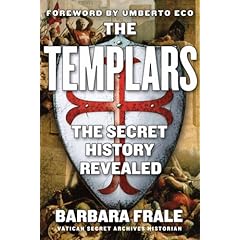The Path of the Templar, by W. C. Peever. This appears to be a second installment of a time travel series. This volume features a Templar theme, something along the lines of the Knights Templar traveling to America before Columbus etc.

From the press release: In this second book of The Jumper Chronicles, twelve-year-old Charlie and his mates discover an ancient compass that stubbornly refuses to point north. Instead, it steers them down a treacherous tunnel, each step taking them deeper into a world of dog-eating trolls, cross-dressing gods, and motorcycle-riding dwarves. As a cloak of darkness threatens to envelop the fellowship, Charlie loses his best friend, discovers true love, and is embraced by unexpected allies who guide him to a long-forgotten treasure that will change the world forever.
 I have finished reading Barbara Frale’s “The Templars: The Secret History Revealed”. Here is something I found rather confusing:
I have finished reading Barbara Frale’s “The Templars: The Secret History Revealed”. Here is something I found rather confusing:
On page 24 one reads the following: “Al-Aqsa mosque, built on the ruins of the Temple of Solomon, was known as the Dome of the Rock because it contained the block of stone from which the prophet Mohammed is believed to have ascended into heaven.” It has always been my understanding that the Al-Aqsa mosque and the Dome of the Rock (Masjid Qubbat As-Sakhrah) were two distinctly different structures (they certainly are today). Leaving aside the history of these mosques (not terribly well documented), it suffices to say that medieval writers certainly describe two separate buildings. The Dome of the Rock is known to them as Templum Domini, and the Al-Aqsa mosque is referred to as Templum Salomonis. Saewulf, for instance, describes the Dome of the Rock (In cuius Templi medietate rupes conspicitur alta et magna et subtus concavata, in qua erant sancta sanctorum: ibi imposuit Salomon archam federis, habens manna et virgam Aaron, quae ibidem floruit et fronduit et amigdalum protulit, et duas tabulas testamenti.), but adds: “In atrio Templi Domini ad meridiem est Templum Salomonis mirae magnitudinis, ad cuius orientalem plagam est oraculum quoddam, habens cunabulum Christi Iesu et balneum ipsius et lectum beatae matris eius testantibus Assyriis.” Initially I thought that an unfortunate translation error caused the conflation of the two buildings. However, on page 85 the Al-Aqsa mosque is again mentioned as the location of a “sacred rock” in connection with the famous story of ibn Munqidh. And yet, on page 111, Al-Aqsa and the Dome of the Rock are listed as two separate Temple Mount buildings that remained in Muslim hands after Frederick’s treaty with Al-Kamil.
The confusion does not end with Ms. Frale, by the way. J. Phillips in his “Holy Warriors: A Modern History of the Crusades”, on page 59, identifies Templum Domini as modern day al-Aqsa Mosque.
Personally, I have always found it confusing that the Crusaders, certainly aware of the fact that the Foundation Rock was located in the Holy of Holies of the original Temple of Solomon, chose instead to refer to the nearby Al-Aqsa mosque as Templum Salomonis. However, medieval sources are very clear on this account.
I was convinced that the theme of the Knights Templar would die out for a few years after being exploited to the max just recently. Apparently, Dan Brown thinks otherwise:
The whole industry is impatient. Book sales are generally sluggish, and one explosive, high-profile title can jump-start sales across the board as customers pour into the stores and walk out with a bagful of titles. When Bertelsmann AG reports 2007 results in March, it will be the first time since 2002 that it didn’t get a boost from “The Da Vinci Code.”
Meanwhile, the nation’s biggest retailers can barely restrain themselves. “We’re constantly asking,” says Bob Wietrak, vice president of merchandising at Barnes & Noble Inc.
So where is the new novel? It’s a mystery worthy of the deepest secrets of the Knights Templar. Mr. Brown, holed up in New Hampshire, isn’t saying. His agent, Heide Lange, isn’t, either.
http://online.wsj.com/article/SB120122061077215305.html
Well, I bet anything that Brown has been looking at this old book:
“Geschichte des Tempelherrenordens, nach dem vorhandenen und mehreren bisher unbenutzten Quellen” by Wilbelm Ferdinand Wilcke.
It is a rather early publication (1826-27) that seems to be full of all sorts of speculations, some of which possible went unnoticed in the ensuing amateurish Templar lore-passing.
Lambuth University has acquired a reproduction of the rare text Proceedings Against the Templars for display in the Luther L. Gobbel Library. An unveiling ceremony will take place at 4 p.m. today, according to a Lambuth press release.
…
On Monday, Lambuth will host an overview lecture about the Knights Templar at noon; “The Da Vinci Code” will be shown in the library at noon on April 1; Lambuth University Religion professors Gene Davenport and Cindy Wesley will debunk The Da Vinci Code and discuss myths of non-mainstream faiths in the library at noon on April 2.
Seriously? They will actually show “The Da Vinci Code” as a part of the festivities commemorating the purchase of a $9000 book published by the Vatican?
http://www.jacksonsun.com/apps/pbcs.dll … 80309/1002



